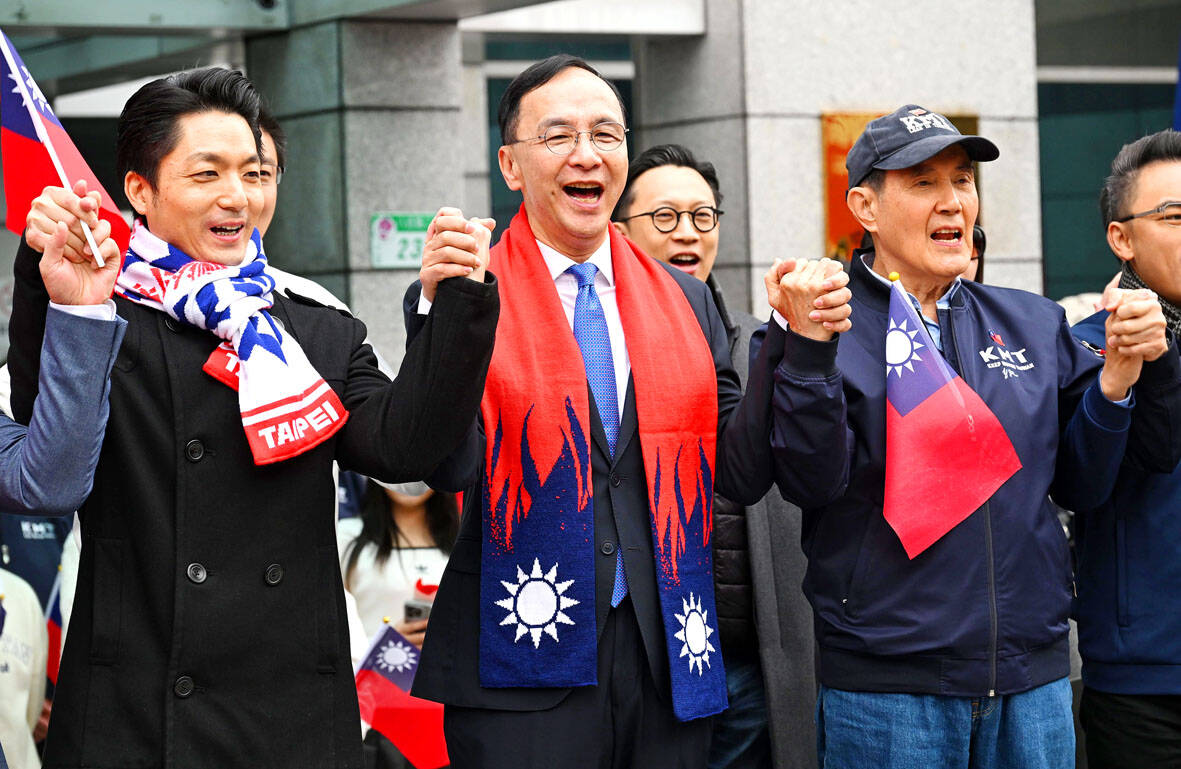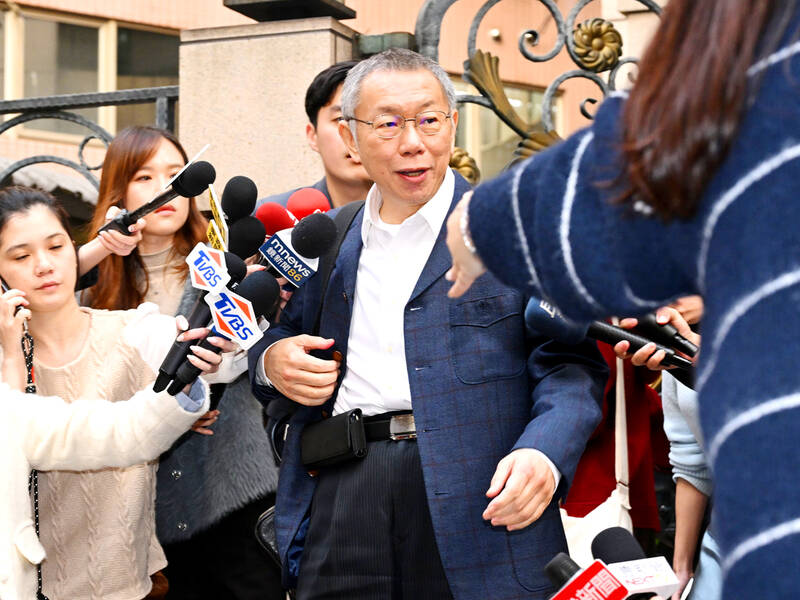These are volatile times for the Taiwan People’s Party (TPP), with the party’s founder, Ko Wen-je (柯文哲), in and out and back in jail repeatedly, Ko resigning as party chair and naming TPP caucus convener Huang Kuo-chang (黃國昌) to replace him and an upcoming party leadership vote. How representative of the party’s supporters has the party’s leadership been recently?
The TPP caucus in the legislature is so closely aligned — and votes so similarly to — the Chinese Nationalist Party (KMT) that they are in effect a pan-blue party now. Billing themselves as the “white force” between the pan-blue and pan-green camps is no longer even remotely true.
Even Ko seemed a little surprised earlier last year and he mentioned asking Huang about it. He said Huang explained that was the best way to get reforms done, and that he could not disagree with his logic.

Photo: EPA-EFE
Both Ko and Huang were once pan-green figures. Huang was a co-founder of the New Power Party (NPP), which was to the left of the Democratic Progressive Party (DPP) and allied with them in the pan-green camp.
Ko had been a big supporter of former president Chen Shui-bian (陳水扁) and seriously considered running for Taipei mayor in 2014 as the DPP candidate, but eventually chose to run as an independent.
HATING THE DPP

Photo: Chang Chia-ming, Taipei Times
Ko’s choice was smart politically — a lot of people hate the DPP. In 2022, RW News ran an interesting series of polls conducted in every special municipality and county and asked voters why they backed the DPP, TPP or KMT.
In most areas of the country, the top reason given by both KMT and TPP supporters was they “hated” the DPP, and in many places by similar margins. Conversely, DPP supporters were more likely to choose the option that they “just like the DPP.”
This phenomenon runs so deep that many of these voters do not care about ideology, are not particularly loyal to the KMT and will consider voting for anyone not branded DPP. The pan-green NPP and even hardcore independence activists like Freddy Lim (林昶佐) got elected in Taipei with the backing of pan-blue voters.

Photo: Chen I-kuan, Taipei Times
Historically, there was a tribal element to this. The KMT generally still has the support of the 49ers, those whose families fled the Chinese Civil War in or around 1949, plus Hakka and Indigenous voters, all minorities compared to the Taiwanese Hoklo speakers.
In the December Formosa poll, KMT and TPP supporters expressed a lack of confidence in President William Lai (賴清德), dissatisfaction with his leadership and negative feelings towards the DPP in percentages that were very highly correlated. For example, 12.3 percent of KMT supporters and 13.2 percent of TPP supporters expressed positive feelings toward the DPP, while 84.6 and 83 percent had negative feelings — differences within the margin of error.
Supporters of both parties have some other things in common. In the November Formosa poll, they were asked, “President Lai has been in power for over six months, which of the following are you dissatisfied with the implementation of by President Lai and the DPP administration?”
They were presented with 16 options. On nine issues, KMT and TPP supporters were within five percentage points of each other.
These issues included inflation, wealth inequality, property speculation, expanding the domestic economy, energy supply, public safety and eradicating drugs, expanding foreign relations, national defense and long-stay care for the elderly.
DIFFERENCES AND DISAGREEMENTS
In spite of the TPP and KMT working so closely together in the legislature, there are some differences between their respective followers.
The nine issues that they were largely in agreement on are fairly widespread concerns. What is more interesting is where they differed.
One issue with a large gap between the two parties was over “unwillingness [by the Lai government] to implement the death penalty,” which at 81.3 percent was the second most upsetting issue for KMT supporters, only after inflation, but was a fairly middle of the pack concern for TPP supporters at 60 percent.
There is a similarly large gap on the issue of food safety, with 43.5 percent of KMT supporters worried about it under the DPP administration, but only 29.1 percent of TPP supporters were concerned. Many TPP followers may be too young to remember how awful food safety used to be.
Another noteworthy gap is on worker rights and welfare but in reverse, with 61.9 percent of TPP supporters concerned about it, but only 49.9 percent of KMT supporters. KMT supporters are likely older and more settled.
The top concern for TPP supporters was justice and judicial reform at 82.2 percent, topping even inflation. Among KMT supporters it was 68.5 percent.
This has been a top issue for Huang Kuo-chang for years, and the TPP is pushing the narrative that President Lai is conspiring with prosecutors to frame Ko and “take him out” politically.
At 72.7 percent, KMT supporters were more concerned about cross-Strait relations than those of the TPP at 63.4 percent. Unfortunately, this question gives no indication in what way they were concerned about this issue, which would be very revealing on this crucial issue.
One indication there may be some daylight between the parties is that nine percent of TPP expressed “somewhat positive” feelings towards the Chinese Communist Party (CCP) with 76.6 percent in the negative column. On the KMT side, 24.3 percent were in the positive column, versus 57.8 percent in the negative column.
Among TPP supporters, 73.9 percent said they trust Ko, versus only 16.6 percent of KMT supporters, of whom the majority, 76.5 percent, do not trust him. On a “trustworthiness scale” of one to 100, the KMT supporters gave Ko 23.2 while those in the TPP camp gave him 68.4.
Of TPP supporters, 38.6 percent viewed the KMT positively while 54 percent viewed them negatively. In the KMT camp, 14.3 percent viewed their own party negatively.
FALL IN LINE
These numbers suggest there is indeed some overlap between the two camps, but not to the level of similarity that their legislative strategy suggests.
Though the TPP caucus has shown a little independence from the KMT, it has been rare. The one time one of their legislators — Vivian Huang (黃珊珊) — pushed back by casting a spoiled ballot, she was fined and punished for breaking rank.
If Huang remains in charge, the TPP caucus appears unlikely to change. There are two ways the situation could change, though.
All TPP legislators were voted in on the party list, rather than being elected to represent an electoral district. All of their legislators have committed to stepping down after two years, allowing the next eight on the list to take their place.
That would mean a new caucus convener, and possibly a change in priorities.
The other is if the party leadership election brings in a group less in favor of Huang, and perhaps more inclined to another leader, such as former lawmaker Tsai Pi-ju (蔡壁如). She just resigned her post as a consultant to the Taichung City Government.
There have been reports, however, that support for Huang is high in the party.
It is even possible that Ko intended for the TPP to be similar to the KMT from the beginning. The original TPP founded in the 1920s had their flag banned by the Japanese for including the KMT insignia and looking too similar to the Chinese nationalist flag.
Donovan’s Deep Dives is a regular column by Courtney Donovan Smith (石東文) who writes in-depth analysis on everything about Taiwan’s political scene and geopolitics. Donovan is also the central Taiwan correspondent at ICRT FM100 Radio News, co-publisher of Compass Magazine, co-founder Taiwan Report (report.tw) and former chair of the Taichung American Chamber of Commerce. Follow him on X: @donovan_smith.

On April 26, The Lancet published a letter from two doctors at Taichung-based China Medical University Hospital (CMUH) warning that “Taiwan’s Health Care System is on the Brink of Collapse.” The authors said that “Years of policy inaction and mismanagement of resources have led to the National Health Insurance system operating under unsustainable conditions.” The pushback was immediate. Errors in the paper were quickly identified and publicized, to discredit the authors (the hospital apologized). CNA reported that CMUH said the letter described Taiwan in 2021 as having 62 nurses per 10,000 people, when the correct number was 78 nurses per 10,000

As we live longer, our risk of cognitive impairment is increasing. How can we delay the onset of symptoms? Do we have to give up every indulgence or can small changes make a difference? We asked neurologists for tips on how to keep our brains healthy for life. TAKE CARE OF YOUR HEALTH “All of the sensible things that apply to bodily health apply to brain health,” says Suzanne O’Sullivan, a consultant in neurology at the National Hospital for Neurology and Neurosurgery in London, and the author of The Age of Diagnosis. “When you’re 20, you can get away with absolute

May 5 to May 11 What started out as friction between Taiwanese students at Taichung First High School and a Japanese head cook escalated dramatically over the first two weeks of May 1927. It began on April 30 when the cook’s wife knew that lotus starch used in that night’s dinner had rat feces in it, but failed to inform staff until the meal was already prepared. The students believed that her silence was intentional, and filed a complaint. The school’s Japanese administrators sided with the cook’s family, dismissing the students as troublemakers and clamping down on their freedoms — with

As Donald Trump’s executive order in March led to the shuttering of Voice of America (VOA) — the global broadcaster whose roots date back to the fight against Nazi propaganda — he quickly attracted support from figures not used to aligning themselves with any US administration. Trump had ordered the US Agency for Global Media, the federal agency that funds VOA and other groups promoting independent journalism overseas, to be “eliminated to the maximum extent consistent with applicable law.” The decision suddenly halted programming in 49 languages to more than 425 million people. In Moscow, Margarita Simonyan, the hardline editor-in-chief of the